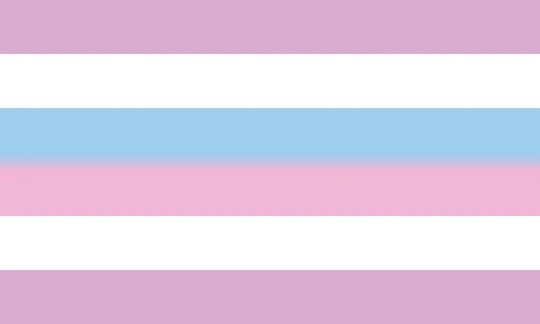#17 KSR deficiency
Explore tagged Tumblr posts
Text
Some intersex flags! (Part 2)
Part 2 of making flags for intersex traits and variations that were flagless! (Part one is here.) There will be a part 3 & 4 and then all the main intersex traits/variations will officially have flags.
Please read (and reblog) our intersex guide. It is so important to understand intersex people, their bodies, and their health!
Accessory Ovary

The flag is based on the uterus didelphys and polyorchidism flags. The A is meant to represent the name of this variation. The three circles are meant to represent ovaries. The plus symbol is meant to stand for people who have more than one accessory ovary (aka 3+ ovaries.)
Supernummary Ovary

The flag is based on the uterus didelphys and polyorchidism flags. The S is meant to represent the name of this variation. The three circles are meant to represent ovaries. The plus symbol is meant to stand for people who have more than one accessory ovary (aka 3+ ovaries.)
Cervical Duplication

The flag is based on the uterus didelphys flag. In the center of the flag, the shape is meant to vaguely resemble a uterus with two cervixes.
Cervical Duplication + Uterus Didelphys

The flag is based on the uterus didelphys flag, with the shapes being changed to vaguely resemble two uteruses with cervixes.
Cervical Agenesis

The flag is based on the MKRH Syndrome flag. The symbol is meant to represent a uterus with an X over where the cervix would be.
Cervical Hypoplasia

The flag is based on MKRH Syndrome flag. The symbol is meant to represent a uterus with a minus symbol over where the cervix would be, representing its smaller size.
Uterine Hypoplasia

The flag is based on MKRH Syndrome flag, with a minus with a minus symbol, representing its smaller size.
Anorchia

The flag is based on the ovarian agenesis flag. The circle with the X represents a lack of gonads.
Monorchidism

The flag is based on the ovarian agenesis flag. The circle in the symbol represents the testicle itself. The 1 represents how there is only one gonad, and the M represents the name of this variation.
Unilateral Ovarian Agenesis

The flag is based on the ovarian agenesis flag. The circle in the symbol represents the ovary itself. The 1 represents how there is only one gonad, and the U represents the name of this variation.
Aromatase Excess Syndrome (AEXS/AES)

The flag uses the hyperestrogenism symbol, as it is a form of hyperstrogenism. The shades of pink represent the feminizing effects of the variation. The rainbow and monochrome coloring represents the gender spectrum, and how any gender can have this variation.
Classic CAH (Simple-Virilizing)

The flag is based on the CAH flag. The SV represents the name of this variation.
Classic CAH (Salt-Wasting)

The flag is based on the CAH flag. The SW represents the name of this variation.
Nonclassic CAH

The flag is based on the CAH flag. The NC represents the name of this variation.
Leydig Cell Hypoplasia (LCH)

The shades of blue represent the masculinizing effects of testosterone. The grey represents hypoandrogenism, and low levels of androgens. The grey circle represents the testes, and the underdeveloped/absent leydig cells within them.
17-KSR Deficiency

The purple and yellow represents that this variation is a form of intersex. The shades of grey surrounding the blue represents the "barrier" preventing androstenedione from converting into testosterone. The Ks and 17 represents the name of this variation.
Aromatase Deficiency

The purple and yellow represents that this variation is a form of intersex. The shades of blue represents the hyperandrogenism, and the pink surrounded by grey represents hypoestrogenism. The AD represents the name of this variation.
Mild Androgen Insensitivity Syndrome (MAIS)

The flag is based on the AIS flag. The M represents the name of this variation.
Partial Androgen Insensitivity Syndrome (PAIS)

The flag is based on the AIS flag. The Ps represents the name of this variation.
Complete Androgen Insensitivity Syndrome (CAIS)

The flag is based on the AIS flag. The Cs represents the name of this variation.
#lgbt#lgbtq#lgbtqia#lgbt pride#queer#educate yourself#body diversity#diversity#intersex#intersex spectrum#intersex community#accessory ovary#supernummary ovary#cervical duplication#uterus didelphys#classic CAH#congenital adrenal hyperplasia#nonclassic cah#17-KSR deficiency#17 KSR deficiency#aromatase deficiency#aromatase excess syndrome#aexs#aes#flag coining#pride flag#mild androgen insensitivity syndrome#mais#partial androgen insensitivity syndrome#pais
77 notes
·
View notes
Text
Intersex




Intersex is a term for those born with physical sex characteristics that cannot be traditionally classified as male or female. Variations may appear in a person’s chromosomes, natural hormones, genitalia, gonads, secondary sex characteristics, or some combination of these things. Intersex variations are observed in many animals including humans. According to the ISNA it is estimated that as many as 1.7% of people are born with intersex traits, however this may be an incorrect estimate, as many individuals are unknowingly intersex due to the fact that external genitalia is the only sex characteristic noticed at birth (in most cases).
Intersex does not describe a specific body type but rather is an umbrella term for a broad range of variations/traits. Some intersex individuals may closely resemble one of the binary sexes, while others are closer to in between. An intersex person may have characteristics of both the male and female sexes, characteristics that fall somewhere in between male or female, or characteristics that don't fall into either.
Intersex individuals may have any gender identity, including male, female, and non-binary. They may identify as cisgender or transgender, or possibly another gender modality such as ipsogender or ultergender. Intersex people can have any assigned gender at birth, some may be AMAB or AFAB because their variation of intersex was not noticed at birth. Others may be corrosively assigned male/female at birth (CAMAB/CAFAB), meaning they had nonconsensual surgery preformed on them so their body more closely fits one of the binary sexes. In some rare cases they are AXAB. Each intersex person has a unique relationship to their gender, assigned gender at birth, the gender they were raised as, and how that relates to their experience being intersex. Intersex is included in the LGBT+ community, though not all intersex people consider themself to be LGBT+ on the basis on being intersex. This is largely a personal choice based on how one's status as intersex has (or hasn't) affected their experiences.
Someone who is not intersex is called dyadic or perisex. Intersex is not an identity, but is something one is born as. Some intersex traits are identified at birth, while others may not be discovered until puberty or later in life (although, the variation was always present, just unnoticed). One cannot "transition to intersex". Dyadic people who desire mixed sex traits may identify as altersex.
Intersex Spectrum
Chromosomal Variations
45,X/46,XY Mosaicism
49,XXXXY Syndrome
De La Chapelle Syndrome
Klinefelter Syndrome
Pentasomy X
SERKAL Syndrome
Tetrasomy X
Triple X Syndrome
Turner Syndrome
XYY Syndrome
XYYY Syndrome
XYYYY Syndrome
XXYYY Syndrome
XXXYY Syndrome
XXYY Syndrome
XXXY Syndrome
Hormonal Variations
Aromatase Excess Syndrome
Aromatase Deficiency
Androgen insensitivity syndrome
Cytochrome PORD
Estrogen insensitivity syndrome
FMPP
Hyperandrogenism
Hyperestrogenism
Hypogonadism
Leydig Cell Hypoplasia
PPSH
Gonadal/Reproductive System Variations
Gonadal agenesis
Gonadal dysgenesis
Hypergonadism
Müllerian Agenesis
Ovotesticular
PMDS
Polyorchidism
Uterus didelphys
Genital Variations
Agenital
Ambiguous Genitalia
Clitoromegaly
Diphallia
Hypospadias
Macrogenital
Penoscrotal Transposition
Gene-Related Variations
17-KSR Deficiency
Ablepharon Macrostomia Syndrome
Barber Say Syndrome
Campomelic Dysplasia
Denys-Drash Syndrome
H Syndrome
Kallman Syndrome
MDP Syndrome
SCARF Syndrome
WNT4 Deficiency
Gland-Related Variations
17-AH Deficiency
Congenital Adrenal Hyperplasia
Intersex-relating syndromes/traits
Aarskog-Scott Syndrome
ATR-16 Syndrome
Bermitra Cryptorchidism
CHARGE Syndrome
Chromosome 18 Ring
Duplikasi Cryptorchidism
Menghapus Cryptorchidism
Mutasi Cryptorchidism
Opitz G/BBB Syndrome
Poland Syndrome
Polycystic Ovary Syndrome
Prader–Willi Syndrome
Seaver Cassidy Syndrome
Secondary Sex Agenesis
Human Chimerism
The most commonly used intersex flag was created by Morgan Carpenter. An earlier flag design was made by Natalie Phox.
99 notes
·
View notes
Text
CTM
CTM or Close To Male is a term for intersex individuals who can be closely described as a male, or described as 'almost male' but aren't actually male. This usually implies one has XY chromosomes, a penis or something similar to a penis, and other masculine traits while not being entirely male.
This term is important, as the term "AMAB" implies that they are assigned male at birth, which isn't always the case, wolffian implies they are not intersex, and POP implies they have a penis, which is not always the case.
Many CTM individuals have XY chromosomes, however they do not have to. Instead, they may have other masculine traits such as testicles, defined muscle, a masculine body, etc. All that matters is that they can easily be classified as 'almost male.'
They may have ambiguous genitals, be on the agenital spectrum, or have a vagina which means they may be assigned female at birth instead. Because of this, calling them AMAB may be incorrect to properly describe their experiences.
The feminine counterpart is CTF.
CTM variations
17-AH Deficiency (XY chromosome version)
17-KSR Deficiency
45,X/46,XY Mosaicism (masculine version)
49,XXXXY Syndrome
Aarskog-Scott Syndrome (XY chromosome version)
Ablepharon Macrostomia Syndrome (XY chromosome version)
Agenital (cryptorchidism, penile agenesis, micropenis)
Androgen Resistance
AMAB Hypogonadism
Aromatase Deficiency (XY chromosome version)
Aromatase Excess Syndrome (XY chromosome version)
ATR-16 Syndrome (XY chromosome version)
Barber Say Syndrome (XY chromosome version)
Campomelic Dysplasia (XY chromosome version)
CHARGE Syndrome (XY chromosome version)
Chromosome 18 Ring (XY chromosome version)
Congenital Adrenal Hyperplasia (XY chromosome version)
Cytochrome PORD (XY chromosome version)
De La Chapelle Syndrome
Denys-Drash Syndrome (XY chromosome version)
Diphallia
Estrogen Resistance
FMPP
Gonadal Agenesis (testicular agenesis)
H Syndrome (XY chromosome version)
Hyperandrogenism (XY chromosome version)
Hypospadias
Kallman Syndrome (XY chromosome version)
Klinefelter Syndrome
Leydig Cell Hypoplasia
MDP Syndrome (XY chromosome version)
Opitz G/BBB Syndrome (XY chromosome version)
Penoscrotal Transposition
PMDS
Polyorchidism
PPSH
Prader–Willi Syndrome (XY chromosome version)
SCARF Syndrome (XY chromosome version)
Seaver Cassidy Syndrome
SERKAL Syndrome
XXXYY Syndrome
XXXY Syndrome
XXYYY Syndrome
XXYY Syndrome
XYY Syndrome
XYYY Syndrome
XYYYY Syndrome
The term CTM was coined by Cryptocrew, specifically Angel, to fill a much needed gap in language.
21 notes
·
View notes